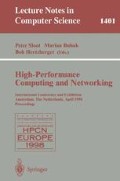Abstract
Atmospheric data such as temperature, moisture, winds, etc., collected by satellites and direct measuements from upper-air instruments, ground observation stations provide only partial information about the atmosphere. They are assimilated to numerical forecasts to provide a coherent, evolving state of the global atmosphere. The data analysis system, the Physical-space Statistical Analysis System (PSAS) developed at the Data Assimilation Office at NASA's Goddard Space Flight Center, requires computing resources far beyond the capabilities of even the state-of-the-art vector supercomputers. Here we describe an efficient and scalable implementation of the PSAS on distributed-memory massively parallel supercomputers such as Intel Paragon and Cray T3E; the implementations achieves superb performance as demonstrated by detailed performance analysis of systematic runs on up to 512 processors on Paragon, T3D and T3E. Consequently, the solution time is reduced to 24.6 seconds on 512-PE T3E from 5 hours on a single head of Cray C90 for a real problem of 80,000 observations, a 740-fold reduction of turn-around time.
Preview
Unable to display preview. Download preview PDF.
References
R. Daley, “Atmospheric Data Analysis”, Cambridge University Press, New York, 1991.
J. Pfaendtner, S. Bloom, D. Lamich, M. Seablom. M. Sienkiewicz, J.Stobie, A. da Silva, Documentation of the Goddard Earth Observing System Data Assimilation System — Version 1, NASA Tech Memo 104604, v.4, Goddard Space Flight Center, January 1995.
S.E. Cohn, A. da Silva, J. Guo, M. Sienkiewicz, and D. Lamich, Assessing the Effects of Data Selection with DAO's Physical-space Statistical Analysis System, Tech Report 97-08, Data Assimilation Office, Goddard Space Flight Center, April 1997.
C.H.Q.Ding and R.D.Ferraro, “A Parallel Climate Data Assimilation Package”, SIAM News, November 1996, pp. 1–11.
C.H.Q. Ding and R.D. Ferraro, “Slices: A Scalable Concurrent Partitioner for Unstructured Finite Element Meshes”, Proceedings of 7th SIAM Conference for Parallel Processing, pp.492–493, 1995.
C.H.Q. Ding and R.D. Ferraro, “A General Purpose Parallel Sparse Matrix Solvers Package”, Proceedings of 9th International Parallel Processing Symposium, pp.70–76, April 1995.
Author information
Authors and Affiliations
Editor information
Rights and permissions
Copyright information
© 1998 Springer-Verlag Berlin Heidelberg
About this paper
Cite this paper
Ding, C.H.Q., Lyster, P.M., Larson, J.W., Guo, J., da Silva, A. (1998). Atmospheric data assimilation on distributed-memory parallel supercomputers. In: Sloot, P., Bubak, M., Hertzberger, B. (eds) High-Performance Computing and Networking. HPCN-Europe 1998. Lecture Notes in Computer Science, vol 1401. Springer, Berlin, Heidelberg. https://doi.org/10.1007/BFb0037138
Download citation
DOI: https://doi.org/10.1007/BFb0037138
Published:
Publisher Name: Springer, Berlin, Heidelberg
Print ISBN: 978-3-540-64443-9
Online ISBN: 978-3-540-69783-1
eBook Packages: Springer Book Archive

